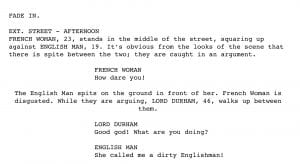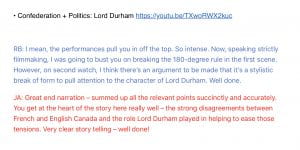What is a Heritage Minute? Well, a heritage minute showcases a treasured part of Canadian history. They’ve been around since the early 90s, and since that time they’ve become a part of Canada’s heritage themselves. With classics such as Wilder Penfield (‘Burnt Toast!’), these educational re-enactments of Canadian history pack information about important figures and ideas in Canadian history into 60 seconds, creating interesting and engaging stories.
For this project, I was grouped with Amelia, Niklas, and Alex. Our task for this project was to create a heritage minute about a piece of Canadian history— a person, thing, or idea,— in one of five categories. These categories were Confederation and Politics, Arts and Culture, Battles and Rebellions, the Fur Trade, and the First Peoples. My group’s category was Confederation and Politics. We chose to do our Heritage Minute on Lord Durham, who was one of the first people to recommend that the colonies of Upper and Lower Canada be united into one colony, separated as Canada East and Canada West. His story is very interesting; he was elected Governor General of the Canadas, and was sent to do a report on the recent rebellions. He resigned as Governor General after only four months, but completed his report anyway. In this report were three recommendations— to unite Upper and Lower Canada, to grant them a responsible government that they would elect themselves, and to unite all of North America for Britain. Two of these recommendations were followed, but America had already rebelled and would not be willing to join the Commonwealth again.
Once we had an idea, we had to go through the video making process.
The first step was to create a story spine, to figure out what structure the video would have. We decided that there would be a scene at the beginning where Lord Durham witnessed a piece of the rebellion, then wrote his report around that. Then, he would summarize, in his voice-over, key parts of the report as he read it and as the queen read it. Then, a couple years later, the Act of Union, uniting Upper and Lower Canada, was passed thanks to his recommendation. We also decided to put this in our video.
Next we wrote a screenplay, which was definitely my favourite part of this project. We used proper screenplay formatting, which was a really interesting experience. Once we’d completed the screenplay, we got some feedback on the formatting and did another draft. After this draft was completed, we were ready to do the next step-storyboarding!
This process took a while, as we had several scenes and lots of shots, especially in the scene when Lord Durham writes his report. We split up the work fairly evenly, and ended up with a completed storyboard.
The next step was very important- filming! We split up who would play each role and took tons of shots with different camera angles. The most difficult part of this stage was finding costumes for characters to wear. We used lots of shawls, dress pants, and plain jackets to achieve the look we wanted. The Queen’s costume was a dress that we repurposed from the 1980s, combined with a matching purple shawl, for royalty.
One of the last steps of creating a video is editing! We did several drafts, each edited differently based on the feedback we were given in-class. We tried a couple different styles of music before landing on this one, and had to change audio levels several times. This all added together to create a video I am really proud of, and by creating this video, I learned a lot about the topic!
Then, we sent this video to Historica Canada (the creators of Heritage Minutes!), and they responded! We’d like to thank Ryan Barnett, who works for Historica Canada, and Joanne Archibald, the Heritage Minute Coordinator, for giving us feedback. We really appreciate it, and it’s really great to know that our work is being seen!
Thanks for reading my blog post!




